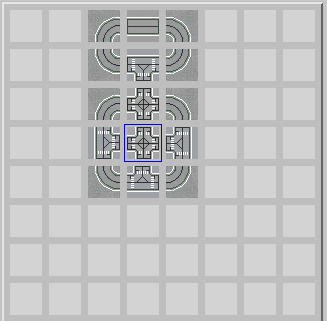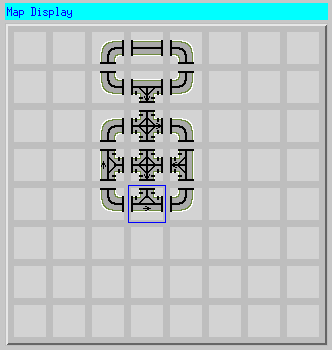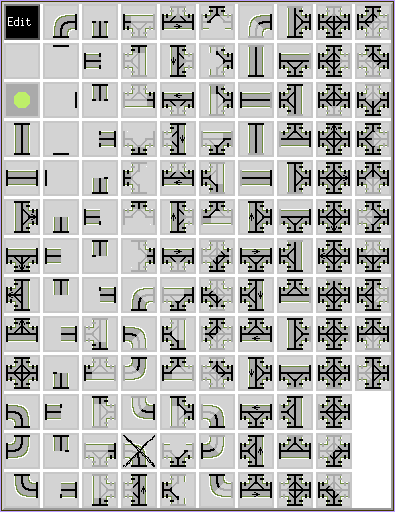Exploring the Map
A rule set and tile state set were created for the compulsory problem,
which will completely explore a LEGO tile course. The compulsory
problem is solved entirely using reflex and tactical level rules.
Here we only describe the tactical rules used.
Terms
-
T
- A 3-way intersection.
-
+
- A 4-way intersection.
- Connection
- A side through which the robot may enter or leave a tile. Straight and
curved tiles have two connections (at opposite ends for a straight tile; on
adjacent sides for a curved tile);
Ts have three connections;
+s have four connections. A connection is explored if the
tile has either been entered or exited through it; it is unexplored if it
has not. When a connection is explored, it is marked on the tile's state
with a line (imitating the actual tile marking).
- Unexplored Tile
- A tile that has never been visited by the robot. A previously unexplored
tile is one that has not been visited before the current execution cycle.
All unexplored tiles except the start tile (which is in the start
state) are in the unknown state.
- Partially Explored Tile
- A tile that has been entered at least once, but which has at least one
unexplored connection.
- Completely Explored Tile
- A tile whose connections have all been explored.
The key features for each tile type were identified, and used to create states
that could mark them as they were found.
It is possible to identify Ts and +s
based solely on the tile markings, while straight and
curved tiles require direction information from the navigator.
The First Tile
We make no assumptions regarding the initial position of the robot when
execution is first started. As long as we are still on the first
tile, we simply follow the line and advance to the
edge of the tile. When we reach the edge (identified by all five
sensors over black), we mark the connection as explored with the

state and use the

navigation command to proceed to the next tile on the map.
There is a situation in which this strategy will result in an error: if the
robot starts on a +, but before the crossing at the center of
the intersection, the crossing will be mistaken for the start of a new tile.
This can be detected and corrected in the course of tile identification, as
will be described below.
Entering a Previously Unexplored Tile
When a previously unexplored tile is entered, it will be in the unknown
state.
Depending on the sensor inputs, we transition to either

(if either
outboard or more than two of the inboard sensors are black) or

In the first case, we remain in the first state until we have left the
black line, and then transition to the second. At this time, we have
recognized that we have entered a new tile, and are past the tile-edge
marker.
Intersections
If an outboard sensor goes black and then white, while no more than two of the
inboard sensors are black, we have encountered tile encoding marks. If a
single encoding mark is detected on one side or the other we have entered
a T from the side; if we detect two encoding marks we have
entered either a T from the bottom or a +. The
states that identify these situations are

If all three inboard sensors go black and the outboard sensors do not, then
the error in identifying the first tile referred to earlier has occurred,
and we are still on the start tile. In this case, we are able to recognize
that the tile we are on now is a +, and we will mark it as such.
The tile to the south is
actually labelled correctly (the marked connection does exist), even though
we have not ever entered or exited it.
If we have entered a T from the side, we will proceed straight
across the top
of the T, marking the tile with the part we explored and the direction we
exited.
If we encountered two stripes, so we have entered either a T
from the bottom
or a +, we will turn right at the intersection (this is much
easier than trying to
disambiguate based on the disappearance of the center line if it's a
T). Before we exit the tile, we
will encounter either a single or a double tape stripe, which will enable us
to disambiguate the tile.
Curved Tiles
The navigator is used to identify curved tiles. If the dead-reckoning
navigation system concludes that we have turned more than 45 degrees since
entering a tile, we enter a state recognizing that we have entered a
turn:

Exiting a Tile, and Straight Tiles
When we reach the tape stripe identifying the end of the current tile (all
sensors go black), we enter one of the states identifying the end
of the tile:

Notice that in the case of a T, the exit used is marked. This is
used to avoid exiting through the same connection the next time we enter the
tile, and reduce the possibility of looping endlessly through a small part of
the course (this is not necessary with a +, as the exit
can be inferred).
If we have reached the end of the tile without recognizing it as anything else,
it is a straight tile, and is recognized at this time

Re-entering a Tile
It may be necessary re-enter a tile that has been either partially or
completely explored. Exploration continues on partially explored
tiles, while completely explored tiles are re-traversed.
The start tile
We treat the start tile as if it were a completely unexplored tile when we
re-enter it. While this reduces search efficiency in some cases (we will have
``forgotten'' that we exited it already), it reduces the number of rules and
states.
Intersection Tiles
In a partially explored intersection, we exit through one of the unexplored
connections. In a completely explored intersection, we exit through a
connection other than the most recently exited one. If we have entered
a partially explored intersection
through its only previously unexplored connection, it has become a completely
explored tile and we treat it as such.
The choice of exits is selected according to the following priorities:
- Search counterclockwise for an unexplored connection. If one is found,
exit through it.
- If all exits have been explored, take the connection next to the last
one used (going counter clockwise), unless this rule would require exiting
through the current entrance.
- Take the next exit (going counterclockwise) from the current entrance.
These priorities are encoded in the line-following rules associated with the
states. Also, in all these cases, the selected exit is marked.
Termination
Each tile state is marked as either a ``terminal'' or a ``Nonterminal'' state.
The unknown and states representing fully explored tiles are terminal
states; states representing partially explored tiles are nonterminal states.
Exploration stops when (1) every tile on the map is in a terminal state, and
(2) the current tile is not in the Unknown state. The first condition captures
the intent that we wish to stop when every tile that has been entered is
completely explored, but will cause us to stop early when we enter a previously
unexplored tile. The second condition handles this special case.
Example
A sample course is

with the result

Tile State Set
The complete tile state set for the compulsory problem, including rotations,
is:

The ruleset has roughly 2100 rules.











